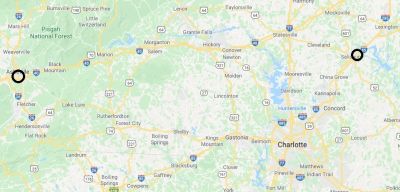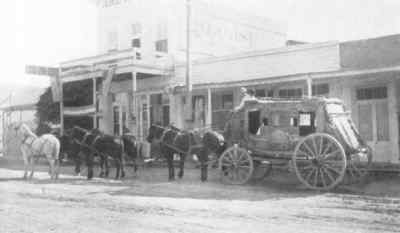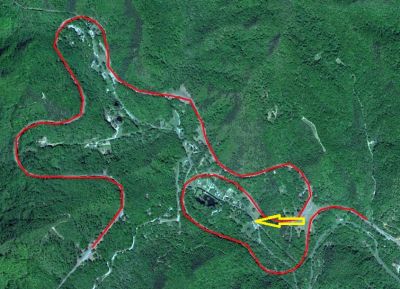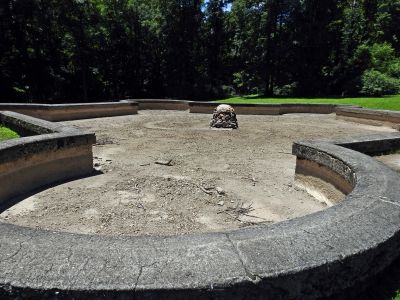Railway west

Map showing the two cities between which the railway would be built. To the east Salisbury in Rowan County, to which there was already rail service from Raleigh and Charlotte, and to the west Asheville in Buncombe County. The line would later be continued to Tennessee and Alabama - or so was the plan.
This article is not, as one might think from the title, about the construction of the railway across the western prairies, which has been chronicled in numerous books and movies, both fiction and fact. The article is actually about the construction of a relatively short railroad line in western North Carolina, but despite the fact that the line was not particularly long, it caused a lot of problems, to say the least, to construct it, and it took many years before it was finished (but not actually completed as originally planned). Today you can make the trip between Salisbury and Asheville by car in just over 2 hours, but it wasn't like that back then. In the mid-1800s, when the only options for transportation were to use stagecoach, ride, or walk. If you had a carriage yourself, you could of course use it, but very few people who arrived by train to Salisbury and had to go on, had access to a carriage. Of "public transportation", only the stagecoach was an option, and it was neither a fast nor a comfortable form of transportation - and as there was no direct connection west, you typically had to take a detour if you wanted to go to Asheville and onward west. The map on the left shows where the two cities are in relation to each other, and I might add that Salisbury is approx. 125 miles west of the state capital Raleigh and about 43 miles northeast of the state's largest city, Charlotte.
The time before the railway
I will not talk about all the different transport options, but will concentrate on the possibility of riding the stage coach, but I can say that if you were to travel on foot, the journey would typically last around 10 days, often longer, not least if you had to transport luggage or other goods. Asheville is about 1,300 feet higher in altitude than Salisbury, which doesn't sound like a huge amount over a stretch of just over 125 miles, but unfortunately it's not a smooth climb. In total, you will have walked about 6,500 feet up and about 5,200 feet downhill before you get there and most of the uphill travelling is on the last part of the trip, not least when crossing the Swannanoa Mountains about 10 or 11 miles from Asheville, but there were also several other places with steep climbs and descents. The same naturally applied if you were on horseback or in your own carriage.

Example of a stagtecoach from the time; not one of the actual stagecoaches mentioned. This one was used in Arizona.
If you travelled by stagecoach, you of course had to
follow the route of that particular stagecoach, and although the stagecoach was
usually faster than being on foot, it made the journey longer, and it also
lasted several days. Stagecoach transportation was not regulated by the
authorities in North Carolina, but was left to private enterprises, who
typically chose to lay out the routes in such a way that they could make the
most of them, and this meant that the routes were not always to the benefit of
the passengers. If, for example, you had to change stagecoach from one company
to another, there was absolutely no coordination between when you arrived and
the next stagecoach left. In the worst case, the stagecoach you had to go on
with could have left the day before - or in the worst case just hours before you
got there, and then it might be a week before the next one left.
The journey itself was not very pleasant either. In the summer the stagecoaches
were scorching hot, and in the winter freezing cold. You also have to remember
that back then there was no such thing as paved roads, so the wheels, which by
the way were built of wood and not suspended in any way, typically kicked up a
lot of dust, so you had to keep the car windows closed, if everything inside was
not to be covered with dust. This could be an advantage in the winter, but made
traveling in the summer even worse. The roads were not smooth, which regularly
caused the wagons to have breakdowns on wheels and axles, further delaying the
trip. Bridges were largely non-existent, so crossing rivers, of which there were
many in the area, was done at fords, and if the water level in the river was
high, the water would enter the cabin, making the passengers wet - and on
occasion the passengers had to leave the carriage and cross such streams on foot
- and then they got wet too.
As the journeys took a long time, you had to spend the night en route at various
stagecoach stations, and here the accommodation was not always the best. There
are numerous examples of complaints about accommodation as well as the
possibility of getting something to eat. The passengers normally had to pay both
rooms and food themselves; it was not included in the price of the journey, as
these stagecoach stops were run by private individuals who were not employed by
the stagecoach companies, but simply had an agreement to provide accommodation,
food and stables for the horses when a stagecoach arrived. Among the known
complaints are the typical ones that these stops were dirty, that you had no
privacy and could not decide for yourself who to share a room with, and that
most often all female passengers had to sleep together, as there was often only
one room for women - and both men and women, typically had to share a bed with
their fellow passengers. You usually had to wash yourself outdoors, and toilets
were outhouses at best, sometimes less than that. The food was also complained
about. One complaint tells of "chicken swimming in black grease accompanied by
lumps of unbaked batter".
A typical route went from Salisbury via Concord, Rutherfordton, Flat Rock, and
Hendersonville to Asheville, extending the trip by about 70 miles. NB! These are
today's towns, not the stops along the way. The name stage coach derives from
the stages into which the trip was divided. Such a stage was typically no more
than 15 -20 miles per day, and on the last part of the trip even less than that,
down to 8 miles. The trip wasn't cheap either. Stagecoaches were typically
pulled by two, four, or six horses, but on the trip to Asheville, six had to be
used, which helped raise the price. When six horses were needed, it was to be
able to pull the wagon up over the mountains, not least the Swannanoa Mountains,
where even six horses had to be changed every 6 miles or so, to get over the
climb, which was around 2,000 feet at the final stretch.
So, all in all, there was a need for better transport options, and here, of
course, the railway came into play. Not least because there was already a
railway line from Raleigh to Salisbury.
Enter the railway
In 1855, the Western North Carolina Railroad Company was
established as a incorporated company with a capital of $2.1 million, of which
the state contributed $1.4 million, while the remainder was contributed by
private investors. The company was to build and operate a railroad line west
from Salisbury to Asheville and on to Tennessee and Alabama, but it was not to
be like that at first.
 The
image illustrates a small section of the railway line, just northwest of Old
Fort.
From here, the line heads due south for a few miles before turning more west
again after crossing today's Interstate Highway 40. The yellow arrow indicates
the location of Andrews Geyser.
The
image illustrates a small section of the railway line, just northwest of Old
Fort.
From here, the line heads due south for a few miles before turning more west
again after crossing today's Interstate Highway 40. The yellow arrow indicates
the location of Andrews Geyser.
Work began in 1858, and although the American Civil War broke out in 1861, workers continued to build the railway until 1863. It was a so-called narrow-gauge railway, which was cheaper and easier to build, and which was often used in mountain areas. In 1863 tracks had been constructed to a place just east of the town of Morganton, 75 miles from Salisbury, or rather from Spencer, which was the railway junction approximately 2 miles east of Salisbury from where the new railway line began. However, it was not the civil war that stopped the construction, but rather the voters. They were dissatisfied with a law which made it possible for private shareholders, who after all only owned a third of the company, to have the railway "visit" and establish stations in the towns where the shareholders lived, thus not coming to towns, which perhaps lay on the direct line between Salisbury and Asheville, but where no stockholders lived. This meant that work came to a standstill for the rest of the Civil War and for a good while after, until the legislation that made it possible was repealed in 1868. At that time, the government decided to split the railroad company into two, the Western North Carolina Railroad Company - Eastern Division and Western North Carolina Railroad Company - Western Division. The "Eastern Division" took over the 75 miles (122 km) of track already laid and was to complete the line to Asheville, while the "Western Division" was given the right to build the railroad between the French Broad River west of Asheville and Paint Rock, Alabama, via Ducktown, Tennessee. However, the Western Division never constructed any part of this railway line. The Eastern Division, on the other hand, had 35 miles of new track laid, so that the railroad now reached Old Fort in McDowell County, west of Morganton. From Old Fort to Asheville, passengers still had to go on extremely difficult and expensive stagecoach trips, while goods had to be transported by wagons.
These 35 miles of tracks were built using something that looked very much like slave labor, even though slavery had been abolished. 500 African-Americans were put to work building the railroad line. These workers were "lent" to the company by the prisons of North Carolina under a system called "convict leasing", which was practiced in most of the former Southern states, but also in several Northern states, where private individuals could "rent" labor in the form of inmates from prisons. The company was responsible for housing the prisoners, as well as providing them with food and clothing, but they did not have to pay wages. In the northern states that practiced the system, the authorities oversaw how the prisoners were treated, but in the southern states, it was entirely up to the companies, as long as they paid the "rent" to the state, which derived large parts of its income from the system. During the construction of the railway, the prisoners were housed in prison-like camps, and were transported to the place where the tracks were to be laid, in hand and foot shackles.
In 1875, the Western North Carolina Railroad Company -
Western Division, that had not yet built anything at all, was sold at foreclosure
auction, and on that occasion the company was completely taken over by the state.
The state therefore took the opportunity to merge the company with the Western
North Carolina Railroad Company - Eastern Division, thus creating what became
known as the Western North Carolina Railroad Company No. 2. Three quarters of
the shares were owned by the state, while private shareholders owned one quarter.
In 1879, the company established around 50 miles of tracks between Old Fort and
Azalea just east of Asheville. This would prove to be the most difficult part of
the whole line, and only after some intense lobbying by a man named Alexander
Boyd Andrews, who had been a colonel during the Civil War but was now director
of the railway company, was money granted, and once more labor from the prisons
to build the tracks was provided. Not least the first approx. 12 miles from Old
Fort to Ridgecrest was difficult, as a total of seven tunnels had to be built on
the stretch and a number of trestle bridges. Added to this was the 1,800 feet long
Swannanoa Tunnel, the construction of which alone cost 23 human lives. In all,
the construction of the line between Old Fort and Asheville cost the lives of
120 workers, mostly among the prison inmates who had been "leased".
When the first train arrived in Asheville on October 3, 1880, the 17-ton
locomotive was pulled by hand by prisoners while others completed the tracks in
front of the locomotive. In total, around 450 died during the work of
constructing the entire line from Salisbury to Murphy. During the construction
of the Cowee Tunnel near Sylva in Jackson County (on the stretch between
Asheville and Murphy), 19 African-American prisoners drowned in the Tuckasegee
River when they fell into the river and were pulled down by their chains. If you
have seen the movie The Fugitive with Harrison Ford, you have also seen this
tunnel, as the scene where Ford walks on a railroad track in a tunnel was filmed
here, and the scene where the train derails and runs into the river was filmed
in nearby Dillsboro, where the wreck of the train that was used can still be
seen on the banks of the Tucksageee River.
 When
there's no water in Andrews Geyser, see below, it's not much of a laugh.
Then it's just a dried up fountain pool.
The railway line runs behind the trees, which did not exist when the geyser was
built.
When
there's no water in Andrews Geyser, see below, it's not much of a laugh.
Then it's just a dried up fountain pool.
The railway line runs behind the trees, which did not exist when the geyser was
built.
In 1880 the company went bankrupt again and was sold at foreclosure and a new company was formed: Western North Carolina Railroad Company No. 3, this time with The Richmond and West Point Terminal Railway and Warehouse Company as the main shareholder, while the state injected a smaller amount, which was mainly used to finance the acquisition of private property where tracks and stations were to be built. The Richmond and West Point Terminal Railway and Warehouse Company did not fare particularly well either, and in 1893 the Richmond Terminal Reorganization Committee took over control of the Western North Carolina Railroad Company. This company succeeded in laying 50 miles of track between Azalea and Paint Rock (North Carolina, not the one in Alabama) north of Asheville during 1882, and between 1882 and 1890 the company laid almost 125 miles of track between Asheville and Murphy in the southwestern corner of the state. Between 1886 and 1894, the entire company structure was leased by the Richmond and Danville Railroad Company, but in 1894, things went wrong for them as well, and the company was sold in yet another foreclosure. The purchaser was the Southern Railway Company, and the name Western North Carolina Railroad Company ceased to exist. The Southern Railway Company exists to this day, but since 1982 under the name Norfolk Southern Railway, but there are no longer passenger trains running to western North Carolina, so today, once again, you have to find other transportation from Salisbury if you want go to the western part of the state. Incidentally, it was the Southern Railway that owned the train that crashed in Danville in 1903, and gave rise to the song The Wreck of the Old 97". This will be the theme for a future article.
Outside Old Fort (in the lower and first of the narrow bends, at the arrow in the photo above), a hotel, the Round Knob Hotel, was built in the early 1880s. An artificial geyser was built at the hotel in 1885, which was named after Alexander Boyd Andrews, who later became director of the Southern Railway. The geyser was supposed to make the hotel more attractive, but was also erected as a monument to the 120 workers who died during the construction of this part of the railway. The hotel burnt down in 1911 and the geyser was no longer maintained, but it was later restored by a friend of Colonel Andrews (which has had to be done several times since) and the area is now a public park. The hotel was rebuilt in the 1930s by a group of railway company executives who wanted to use it as a resort, and the building still exists - albeit as a private home. Unfortunately, the geyser only erupts on special occasions, as they want to save water. This comes from an artificial pond located on the mountain above the area where you find the Inn on Mill Creek Bed & Breakfast today. From the pond, a pipe with a diameter of 10 inches leads the water the two miles down to the geyser. The height difference of around 550 feet means that when the geyser is in operation, the pressure will send the water in the geyser up to a height of 80 feet. However, it cannot work for too long at a time, because then the water level in the pond drops so much that the water can no longer flow through the pipe.